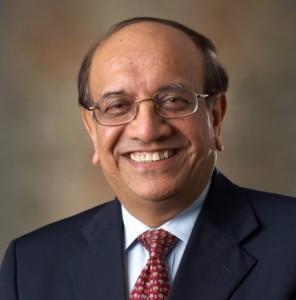
In the 25 years since India’s most well-known IT services trade group National Association of Software and Services Companies (NASSCOM) was formed, the country’s global outsourcing industry has experienced tremendous growth, but also its share of ups and downs.
Outgoing NASSCOM president Som Mittal, who took office in 2008, led the group during a particularly tumultuous time for the industry, from the global economic crisis to the Mumbai terrorist attacks to the introduction of cloud computing and automation technologies that threatened the country’s traditional outsourcing model.
As Mittal prepared to hand the NASSCOM reigns over to R. Chandraschekhar, we talked to the IT industry veteran (who previously held leadership positions at HP, Digital, and Wipro) about immigration policy and protectionist politics in the U.S., political and economic instability at home, and what the future may hold for the Indian IT services industry.
What did the Indian IT industry learn from the global economic downturn?
Som Mittal, former president of NASSCOM: For our industry this was the first-ever headwinds we saw. Previously, we had seen only sequential quarter-over-quarter growth. It impacted not just the Indian companies here but the multinational companies and captive centres in India as well. I don’t think anybody was prepared for the surprise of that nature.
Fortunately the industry realised that it was too valuable a crisis to lose. IT service providers took it as an opportunity to change their business models. They became more nimble-footed. They changed the way they hired. They changed their structures from tech-driven to more verticalised.
They evolved from full-time employee (FTE) based pricing to outcome based pricing. The entire sector has come out stronger now. During this period, there was a lot of innovation. Some of that was driven by our customers who were transforming themselves.
How will the proliferation of cloud-based solutions and increasing automation challenge the India services model of leveraging large number or relative cheap and skilled resources? Will India lose its advantage?
Our industry is 25-years-old. It has matured a lot. Cheaper, better, faster is now a given. Customers are looking beyond costs. Technology has become consumerised, whether you’re talking about social media, cloud computing, analytics, or mobility. All of these are now getting integrated into IT services.
There might be a presumption that these will cannibalise some of our business. But we’re actually seeing the opposite. Revenues are increasing because of cloud computing.
Our industry had previously been focused on the Fortune 500 and then the Fortune 1000. But now we’re seeing more opportunity with helping small to medium-sized enterprises leverage this new technology.
Is India’s old sourcing model dead? Will outsourcing firms now move to as-a-service type pricing?
There’s an evolution going on. There is work that still happens on FTE basis. More and more companies are shifting their focus from FTE and SLAs to outcomes. Large customers in the last few years are saying, “You’ve done what we have told you to do. Please tell us what more can you do for us?”
The buyers are changing their approach as much as the solution providers. And the buyer is no longer just the CIO. As analytics have grown, we’re seeing more business people making buying decisions. Technology is becoming so complex that companies find it difficult to do it all in-house so they’re outsourcing more. There are certain areas that are core and need proximity and domain expertise, but the rest can be outsourced. And what is outsourced will get partially offshored.
Firms like Infosys, TCS and Cognizant still based the majority of their staff in India. Are your major IT services firms in danger of falling into the same trap as the Japanese companies in the 1990s that failed to globalise their businesses?
You have to look at the nature of our work and where we started. If you look at the large U.S. and European service providers like IBM, Cap Gemini and Accenture, they were entirely based in their home countries. Then they started to expand offshore in India and the Philippines and elsewhere.
Today, about 20 percent of the work from Indian service providers happens at the customer’s site, and that is increasing. Most companies are setting up development centres in the U.S., the U.K., Latin America, and elsewhere so that they can be in the customer’s time zone.
Companies do struggle a bit in the U.S. because it’s difficult to hire skilled IT workers. There are shortages as documented by U.S. Department of Labour numbers. That’s the reason why companies like Microsoft and Oracle and financial service companies are expressing their need for more visas.
What is NASSCOM’s stand on the current U.S. visa situation and potential immigration reform?
Over the last 10 years, U.S. attempts at visa reform haven’t happened. The current immigration reform bills include many provisions that are positive such as increasing visa limits and green cards. Unfortunately, there are some very restrictive and discriminatory visa clauses in the U.S. Senate version of immigration reform.
Over the last several months, there has been increasing realisation that those restrictions would harm U.S. businesses that need those highly skilled resources. The U.S. House of Representatives version does not contain such provisions. We are hopeful that in the coming year, when immigration reform comes back for discussion and debate, the positive provisions will remain and the negative provisions will be dropped.
The U.S. is a large market for us. Over the last four to five years during U.S. election cycles, we’ve seen American job losses being linked to our sector, which is odd. In reality, while jobs were disappearing in manufacturing and construction, they were being added in the tech space.
Our industry has helped to create more than 280,000 American jobs. We’ve contributed more than $15 billion in tax and social security revenues. And we’re helping the U.S. become even more competitive. If you look at the business model for IBM or Accenture, it’s no different than those embraced by Indian IT service providers. We need to do a better job educating our stakeholders in the U.S. on these facts.
CIO.com: How will political and economic instability in India — slowing growth, rising inflation, weakening exchange rates, corruption and cronyism, geopolitical unrest — impact the overall economy in general and the services sector specifically?
Mittal: We are going through a transition. The services sector has been growing quite well. It’s actually the industrial sector that has impacted growth. We had some issues related to policy paralysis largely in the manufacturing sector because of coalition politics here. However, if you look at the last two or three years, our IT industry grew at about 12 to 14 percent, and we expect that to continue in coming years. Hiring continues.
Some of the problems our sector was facing related to the tax regime, which we’ve been able to resolve. A lot of U.S. companies were having problems with transfer pricing assessments. But in the last twelve months, a lot of that has been resolved, too, and things are looking up.
We have elections coming in May, but I don’t think the direction will change regardless of who is elected.
We need to work harder to communicate our value proposition. But our IT providers are differentiating themselves by focusing on verticals. They’re doing far more platform-based delivery. They’re building up domain expertise where they had previously been focused on technical expertise. It’s become about how technology can help the business.
Will the country be moving more aggressively into other industries that are not so dependent on U.S. corporate spending?
We’re doing more and more work in Europe. We’re seeing a lot of traction in Latin America. We’ve seen Japanese companies who had been resisting offshore outsourcing starting to embrace it.
The U.S. customer base is large and will continue to grow. IT currently accounts for 61 percent of our work and I don’t seeing it shrinking to less than half. But there is a major shift happening as other geographies that had underinvested come to the table. Besides IT services and business process management, we’re seeing growth in engineering services and embedded software.
We’re seeing changes happen here in India as the country is setting up a very large fibre optic network that will offer broadband connectivity to 250,000 villages in the next two years. We already have 900 million people on voice and we’re gradually moving them to data.
There will be a lot more innovation happening as India leverages technology to serve its own citizens, particularly within smaller startups who are developing India-centric solutions that will be applicable to other developing countries. That’s why at NASSCOM we developed a program, sponsored by Google, Microsoft, and VeriSign, aimed at creating 10,000 tech start-ups in India over ten years.
What other sorts of initiatives is NASSCOM backing to deal with issues like talent development and growth in tertiary cities?
We need to do far more work at NASSCOM to rally our stakeholders around how IT can be leveraged in India for India. We launched a digital literacy initiative with the goal of making sure that one person in every household where fibre reaches will be digitally literate. If that happens, that will change lives.
We formed the IT Sector Skills Council to make sure graduates coming out of colleges are more industry-ready. Technology is changing so rapidly, we have to work harder to make new employees more productive. We offer short programmes post-college to provide them with some specialisation early – for example in software development, infrastructure management, or embedded systems – rather than just a generic skill set.
Today we have seven large cities where 90 percent of the work happens. But those centres are staffed by people who came from different towns and cities. Having those hubs was important for customers who wanted to visit and need to be in a city with international flights. But our customers are more experienced now and our models have matured.
Customers do not insist on a specific location anymore. We’re seeing the emergence of tier two and three towns. By 2020, 40 percent of our work will happen at new centres in Jaipur and Coimbatore, for example. The biggest problem there is that, while we have enough entry-level resources, we have to move middle managers there.
What do you make of the emergence of potential competitors to India such as China, the Philippines and Sri Lanka?
There will be competition. But if you look at what’s happening in the Philippines, for example, a large number of customers doing work there also do work in India. They look to the Philippines as a business continuity and disaster recovery site. Many of our Indian companies have centres there.
China has the scale to compete with India, but the majority of the work they do is for Japan and north Asia. They do some work for the U.S., but it will take some time before they have mature processes and management.
We employ 25,000 Chinese professionals helping multinationals manage their IT infrastructure there. But China still has to address a couple of issues. They do extremely well with manufactured products, but customers tell us it is difficult to do services work with them. They also have to work on intellectual property and security issues.
Is there anything you would have liked to accomplish during your tenure that you didn’t? Or anything you would have liked to have changed sooner?
I wish we could have done more to drive the domestic agenda. We do all this work for customers overseas, but India hasn’t leveraged technology as much. We got stuck on global issues.
I wish we could have positioned our value proposition better in North America and Europe, letting those societies know that we’re part of the solution, not the problem. Our customers understand that but, given the economic downturn and all the rhetoric around unemployment, we could have managed that better and earlier.
What do you want to be remembered for during your time at NASSCOM?
I think we braved the downturn well. We had our own issues on 26/11 [the 2008 Mumbai attacks]. There were major issues around the world related to cybersecurity and protectionist regimes. I think we navigated it all pretty well.
We worked well with the U.S. companies who are also our members and resolved the long-standing tax issues that were creating uncertainty for them in India. We set up the Data Security Council of India to establish, monitor and enforce privacy and data protection standards for our industry. In fact, we continue to collaborate with our counterparts around the world on data security because it’s something that no country is protected from. We’re all vulnerable.
We worked well with organisations like the U.S. Chamber of Commerce, the Brookings Institution, the Heritage Foundation and the Cato Institute to create more understanding with our stakeholders.
We went to work at a time when things appeared to be going south, but we were fortunate. Our entrepreneurship and products have picked up well. Things seem to be on a good track.





